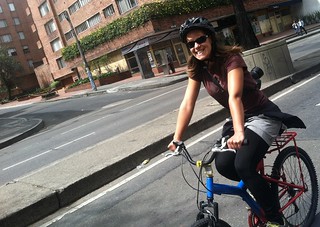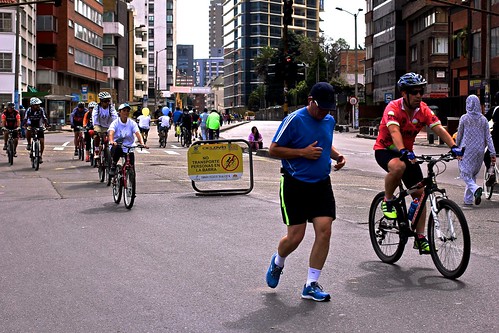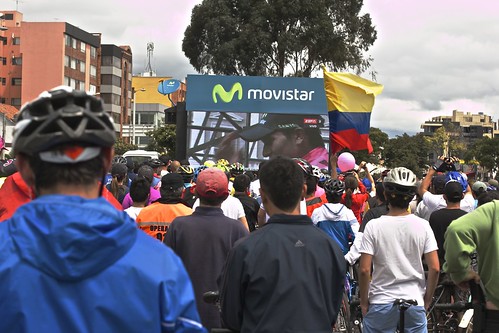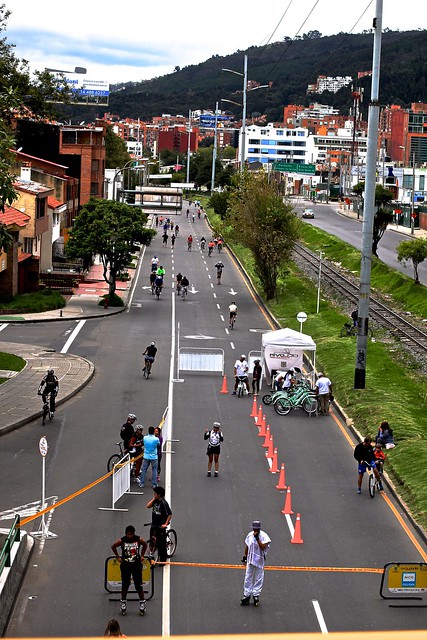Portland resident Jen Sotolongo and her partner Dave Hoch recently returned from a trip to Bogotá, Colombia where they took part in “Ciclovía” — the event inspired our own Sunday Parkways and that’s considered the Godfather of open streets events around the world.
Story and photos by Jen Sotolongo
——
We awoke from our short morning nap after a sickeningly bouncy, seven-hour night bus ride from San Gil, Colombia to Bogotá, feeling somewhat less nauseous, a touch more rested, and most of all, ready to take to the streets of Bogotá for Ciclovía.
Every Sunday and holiday from 7AM until 2PM, the city opens over 70 miles worth of roads… Think Sunday Parkways, only the whole city, rather than single quadrants… Every. Single. Week. All year round.
Every Sunday and holiday from 7AM until 2PM, the city opens over 70 miles worth of roads, including major thoroughfares, to bicycles, runners, and a surprising amount of inline skaters only. This weekly event attracts some 2 million people, or about 30% of the population. Think Sunday Parkways, only the whole city, rather than single quadrants, dedicates its roads to cyclists and pedestrians. Naito, Burnside, MLK, Powell Blvd, Barbur, 82nd, and the Fremont Bridge become a safe haven for active transportation. Every. Single. Week. All year round.
City parks become fitness centers, with aerobics instructors calling out dance instructions. Pop-up maintenance stations and food carts selling a variety of deep fried items like arepas and empanadas, as well as delicious and refreshing salpicón, a juice drink featuring chunks of tropical fruit, appear every few miles along the route.
Launched as a pilot program in 1976, Bogotá has hosted the longest-running and largest Ciclovía in the world. The event increasingly grew, particularly during the 1990s when Mayor Enrique Peñalosa and his brother, Guillermo Peñalosa, Parks Director, decided that Bogotá would become a city for the people.
Mayor from 1998-2001, Peñalosa famously overhauled the streets of Bogotá and created more than 350km of protected “ciclorutas,” bike lanes completely separated from traffic, advocating that cities should be designed for people, not for cars. A matter of social justice and equality, he set out to demonstrate the bikeway as “a symbol that shows that a citizen on a $30 bicycle is equally important as a citizen on a $30,000 car.”
After peeling ourselves from our comfortable bed, we lugged the heavy, completely-out-of-tune bikes left for our use by our AirBnB hosts and headed down a few blocks to Carerra 7, a six-lane traffic route that also has a buffered lane for cyclists down one side. At 8:30 in the morning, the streets were completely packed with cyclists (and their dogs!), inline skaters, runners, vendors, and pedestrians.
Advertisement
We cycled past city parks, city-commissioned political murals, the strange ritzy neighborhood with U.S. chain stores, and along the city’s ciclorutas. Perhaps the most exciting moment along the ride was joining a large crowd of excited Colombians, watching their own Nairo Quintana win the Giro d’Italia on a giant video screen. If you didn’t follow the Giro, Colombians dominated the race, taking first, second, and King of the Mountain. In a country where the cyclists are just beginning to emerge as elite athletes, the pride was imminent throughout the ride.
By the time we finished our ride, it was well into the afternoon. Carrera 7 was chock a block with people and vendors and guinea pig races. The scene was chaotic and we traveled slowly as we made our way through the crowd back to our AirBnB. The festivities continued throughout the day because, as luck would have it, the following day was a holiday, and we were awarded with another day on our bikes through the streets of Bogotá.
An early flight from Bogotá to the Caribbean Coast the morning after our arrival in Colombia reminded me a bit of Portland. The skies were gray, with a light rain misting the ground. Cyclists peppered the scene donning rain gear, helmets, and panniers on their way to work. Bus stops housed giant bicycle cages that held hundreds of bikes for multi-modal commuters. Morning runners were out with their dogs on leashes. People were outside getting exercise, something I’ve seen infrequently during my extensive time spent in Latin America.
Ciclovía is more than just about creating an opportunity to encourage physical activity and active transportation, however. It connects some of the wealthiest neighborhoods to the poorest. Corporate executives mounted on bikes worth thousands of dollars ride alongside the minimum-wage earner on a bike that costs just a few. Hundreds of thousands of people gather together every Sunday of the year as part of a single community. From the hours of 7AM to 2PM in Bogotá, all citizens are equal.
In 2013, Sunday Parkways attracted 85,480 participants over the entire series (with the SW September ride cancelled due to inclement weather conditions). Like Sunday Parkways, Ciclovía started out small, with just 15km of closed roads. By using existing infrastructure, an army of dedicated volunteers and proper management, little capital investment was needed to expand Ciclovía into what it is today. With Portland’s already strong community, dedicated recreationists, and grassroots ethos, Sunday Parkways certainly has the capability to expand and rival Ciclovía.





